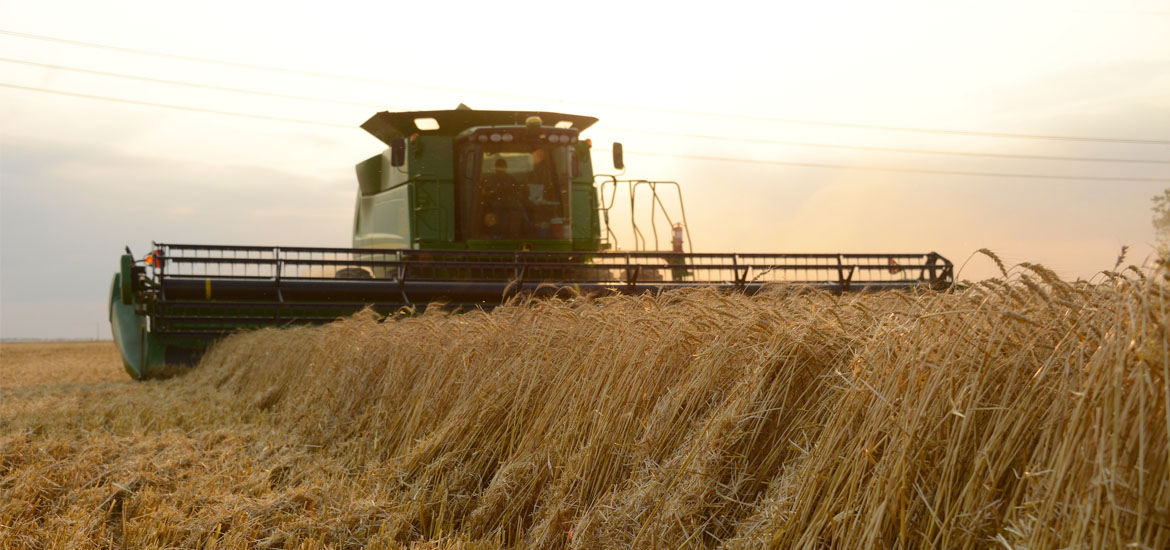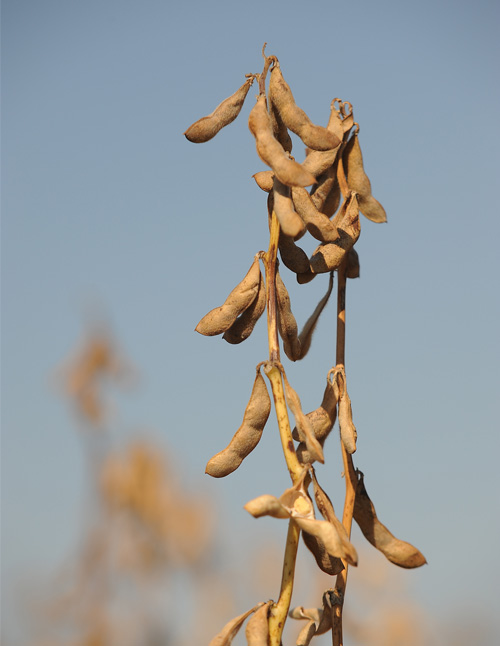
Crop Whisperers
Wednesday, August 1, 2018
OSU joins effort to create a global monitoring system for crop diseases
By Leilana Mckindra
These days, the journey our food takes from farms and fields to our forks often draws a lot of attention. But just like the family vacation that doesn’t go quite the way we mapped it out, sometimes crops run into roadblocks on the way to the dinner table. For instance, what happens when a potentially devastating crop or plant disease hopscotches around the world and, without warning, lands at our doorstep in Oklahoma or elsewhere in the United States?
Consider that a crop disease caused the mid-19th century Irish Potato Famine, which led to about 1 million deaths in Ireland.
It’s a frightening question with no easy answers. But that isn’t stopping Oklahoma State University’s National Institute for Microbial Forensics and Food and Agricultural Biosecurity from taking on the challenge.
The institute is joining other universities, agencies and organizations worldwide in a strong push to establish a global surveillance system for crop diseases.

While the U.S. is capable of tracking various ongoing outbreaks in any given year, the organization and emphasis on biosecurity isn’t as strong elsewhere, and that’s where possible gaps exist, said institute director Kitty Cardwell. The institute is the only one in the nation dedicated to microbial forensics in agriculture, a discipline that focuses on unusual or unexpected food or agricultural crop disease outbreaks.
“If we don’t know what’s going on in other countries, what happens in any part of the world can happen here. It’ll come either on the air or in an airplane, in trade goods or in wood packing materials,” she said. “If we don’t know what things are out there, we don’t know to look for them here.”
Cardwell joined a slate of global experts representing nearly 20 organizations in Lake Como, Italy, in February to hammer out a proposal for a monitoring system that would work through the 15 already established independent, nonprofit research centers affiliated under the Consultative Group for International Agriculture Research.
These research centers, based everywhere from the Philippines to Lebanon to Peru to Mexico, represent regional key crop systems. Each would be responsible for gathering crop disease data for its region, then uploading that data into a platform to create a global picture of where pests and diseases are causing trouble.
The initial focus would fall on crops with strong international importance such as wheat, corn and rice, but as the surveillance system evolves, local crops could be added.
“As you’re watching a system like this and you see a disease is spreading, one thing we can do is work with the governments in countries at risk to help them develop a management and recovery plan,” Cardwell said. “You can plan and at least not be caught flat-footed or completely unaware.”
A real need
With no funding yet, the proposed surveillance system remains a concept, but the need for it is real.
Crop diseases affect growers, of course, but also can inflict pain on residents, consumers and local economies. Last year, wheat blast, a quick-striking fungal disease that can shrivel and deform the grain within days of the first symptoms, infected 100 percent of the crop in Bangladesh, significantly affecting local wheat production.
“That crop disease was moved from Brazil. It wasn’t intentional. They were shipping food aid, and the wheat had this fungus on it,” Cardwell said. “If there had been a global system, it could have been prevented.”
Another strong argument for a global surveillance system is the reality that there’s always an outbreak or concern brewing somewhere in the world.
As an associate OSU Cooperative Extension specialist, Jennifer D. Olson educates people about emerging and invasive plant pathogens and pests threatening Oklahoma’s agriculture.

“Often the people I train are unaware that threats are all around them. Some of the most immediate include emerald ash borer, thousand cankers disease of walnut and brown marmorated stink bug,” said Olson, who also is a diagnostician with OSU’s Plant Disease and Insect Diagnostic Laboratory. “Personally, I am constantly pulling over on the side of the road to examine a crop or landscape plants to assess why they are in decline.”
The good news is, according to Monica Carvajal, a digital gene bank scientist with the International Center for Tropical Agriculture and an organizer of the summit in Italy, plant protection networks established in some countries and regions have proven to work well.
She pointed to the National Plant Diagnostic Network in the U.S. and the European and Mediterranean Plant Protection Organization as solid examples.
But, she said in other less developed areas of the world, there’s less knowledge, expertise and infrastructure to detect and respond well to outbreaks of crop diseases.
“It is estimated that at least 10 percent of the global food production is lost due to plant diseases and with the expected increase in human population, the food demand will, consequently, increase,” Carvajal said. “Pathogens know no borders; therefore, reducing crop disease is of global concern, therefore we need a global surveillance system.”
Protecting the homeland
Launched in 2002 as part of an urgent and aggressive effort to more strongly secure American agricultural assets after 9/11, the United States’ surveillance network harnesses the expertise of diagnostic labs at land-grant universities across the nation. As Cooperative Extension educators, growers and homeowners bring samples into these labs, diagnosticians analyze them and load that data into a national repository.
“Because the diagnosticians are networked, they talk with each other about what they’re seeing. It’s really a communications system that allows ongoing, real-time monitoring. If something unusual pops up, they may be the first to notice,” said Cardwell, who co-developed the network during a stint with the U.S. Department of Agriculture’s National Institute of Food and Agriculture.

“The NPDN allows us to be very responsive. If something’s coming and we see it, the network can prepare first responders,” Cardwell said. “Also, if something is happening in the country and we think it’s spreading, the network gives you a lot of hands and laboratories to manage a surge of diseased plant samples.”
A good example of the network’s capabilities was on display when soybean rust arrived in the U.S. from South America in 2004 on the brutal winds of Hurricane Ivan. The fearsome foliar disease known to affect the leaves of the plant can cause 100 percent crop loss.
Thanks to coordinated surveillance efforts, the nation was prepared and the disease has been under control since its arrival.
“We saw it coming and were ready for it,” Cardwell said. “We would like to have that kind of capacity around the world.”
OSU’s laboratory is a national network member. Olson said the lab constantly monitors for pests or pathogens new to Oklahoma or that show atypical symptoms and has a system for confirming and reporting any new or unusual findings.
The network helped connect previously independent labs across the nation, she said, and established standard operating procedures for monitoring, reporting and confirming diagnoses when identifications were made in new areas.
From that perspective, Olson can see how a global monitoring system could be useful as the world moves an increasing quantity of plant products internationally.
“On some level, monitoring is in place for trade allowances or restrictions between countries,” she said. “However, many other countries do not have the equivalent of NPDN so their plants and plant products are not being routinely monitored for pests or plant pathogens. There may be a gap in knowledge about pests and pathogens that we are moving internationally.”
Looking ahead
Securing funding for the proposed global surveillance system is the next crucial step in the project. A white paper aimed at attracting backers is under development.
Some tricky diplomatic work also needs to be done before the system is fully operational.
“A lot of countries don’t want anybody to know what their crop diseases are because it could impact trade,” Cardwell said. “There has to be a global acceptance that some important diseases of important crops are going to be globally monitored. It would take pretty extensive communications to get countries to buy into it.”
Meanwhile, in anticipation of this ambitious initiative ultimately receiving a green light, OSU’s institute has submitted some concept papers to potential donors and stands ready to contribute its considerable expertise and resources.
“In a lot of ways, NIMFFAB is at the forefront and on the cutting edge of diagnostic technology,” said Cardwell, who mentioned that the institute has developed a unique web interface that could be adapted for use in this important international effort. “If people around the world were using it or something like it, they’d automatically have diagnostic data in a web platform that would allow visualization. We’ve got tools in place.”
